Seat Alhambra 2007 Workshop Manual
Manufacturer: SEAT, Model Year: 2007, Model line: Alhambra, Model: Seat Alhambra 2007Pages: 291, PDF Size: 9.13 MB
Page 51 of 291
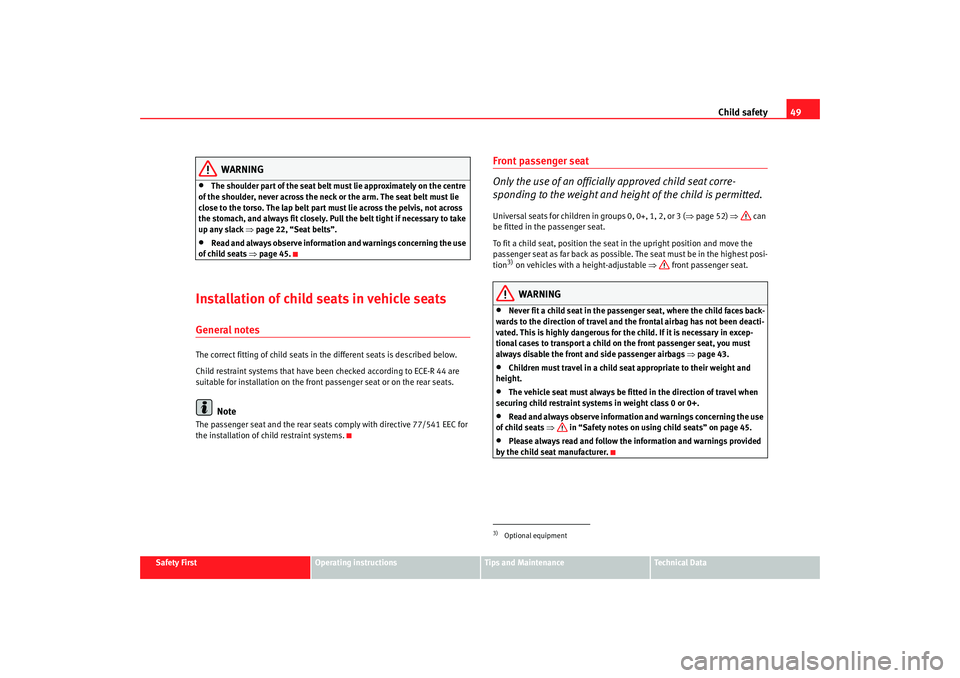
Child safety49
Safety First
Operating instructions
Tips and Maintenance
Te c h n i c a l D a t a
WARNING
•
The shoulder part of the seat belt mu st lie approximately on the centre
of the shoulder, never across the neck or the arm. The seat belt must lie
close to the torso. The lap belt part must lie across the pelvis, not across
the stomach, and always fit closely. Pull the belt tight if necessary to take
up any slack ⇒page 22, “Seat belts”.
•
Read and always observe information and warnings concerning the use
of child seats ⇒page 45.
Installation of child seats in vehicle seatsGeneral notesThe correct fitting of child seats in the different seats is described below.
Child restraint systems that have been checked according to ECE-R 44 are
suitable for installation on the front passenger seat or on the rear seats.
Note
The passenger seat and the rear seats comply with directive 77/541 EEC for
the installation of child restraint systems.
Front passenger seat
Only the use of an officially approved child seat corre-
sponding to the weight and height of the child is permitted.Universal seats for children in groups 0, 0+, 1, 2, or 3 (⇒ page 52) ⇒ can
be fitted in the passenger seat.
To fit a child seat, position the seat in the upright position and move the
passenger seat as far back as possible. The seat must be in the highest posi-
tion
3) on vehicles with a height-adjustable ⇒ front passenger seat.WARNING
•
Never fit a child seat in the passenger seat, where the child faces back-
wards to the direction of travel and the frontal airbag has not been deacti-
vated. This is highly dangerous for the child. If it is necessary in excep-
tional cases to transport a child on the front passenger seat, you must
always disable the front and side passenger airbags ⇒page 43.
•
Children must travel in a child seat appropriate to their weight and
height.
•
The vehicle seat must always be fitt ed in the direction of travel when
securing child restraint systems in weight class 0 or 0+.
•
Read and always observe information and warnings concerning the use
of child seats ⇒ in “Safety notes on using child seats” on page 45.
•
Please always read and follow the information and warnings provided
by the child seat manufacturer.
3)Optional equipment
alhambra ingles.book Seite 49 Donnerstag, 19. April 2007 4:04 16
Page 52 of 291
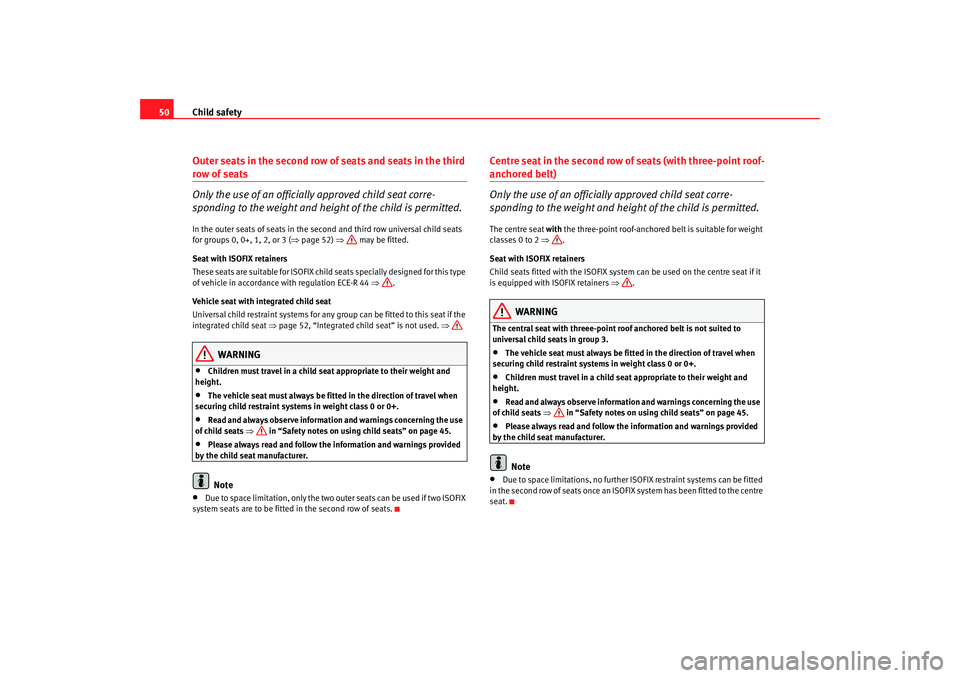
Child safety
50Outer seats in the second row of seats and seats in the third row of seats
Only the use of an officially approved child seat corre-
sponding to the weight and height of the child is permitted.In the outer seats of seats in the second and third row universal child seats
for groups 0, 0+, 1, 2, or 3 ( ⇒page 52) ⇒ may be fitted.
Seat with ISOFIX retainers
These seats are suitable for ISOFIX child seats specially designed for this type
of vehicle in accordance with regulation ECE-R 44 ⇒.
Vehicle seat with integrated child seat
Universal child restraint systems for any group can be fitted to this seat if the
integrated child seat ⇒page 52, “Integrated child seat” is not used. ⇒
WARNING
•
Children must travel in a child seat appropriate to their weight and
height.
•
The vehicle seat must always be fitt ed in the direction of travel when
securing child restraint systems in weight class 0 or 0+.
•
Read and always observe information and warnings concerning the use
of child seats ⇒ in “Safety notes on using child seats” on page 45.
•
Please always read and follow the information and warnings provided
by the child seat manufacturer.Note
•
Due to space limitation, only the two outer seats can be used if two ISOFIX
system seats are to be fitted in the second row of seats.
Centre seat in the second row of seats (with three-point roof-anchored belt)
Only the use of an officially approved child seat corre-
sponding to the weight and height of the child is permitted.The centre seat with the three-point roof-anchored belt is suitable for weight
classes 0 to 2 ⇒.
Seat with ISOFIX retainers
Child seats fitted with the ISOFIX system can be used on the centre seat if it
is equipped with ISOFIX retainers ⇒.
WARNING
The central seat with threee-point roof anchored belt is not suited to
universal child seats in group 3.•
The vehicle seat must always be fitt ed in the direction of travel when
securing child restraint systems in weight class 0 or 0+.
•
Children must travel in a child seat appropriate to their weight and
height.
•
Read and always observe information and warnings concerning the use
of child seats ⇒ in “Safety notes on using child seats” on page 45.
•
Please always read and follow the information and warnings provided
by the child seat manufacturer.Note
•
Due to space limitations, no further ISOFIX restraint systems can be fitted
in the second row of seats once an ISOFIX system has been fitted to the centre
seat.
alhambra ingles.book Seite 50 Donnerstag, 19. April 2007 4:04 16
Page 53 of 291
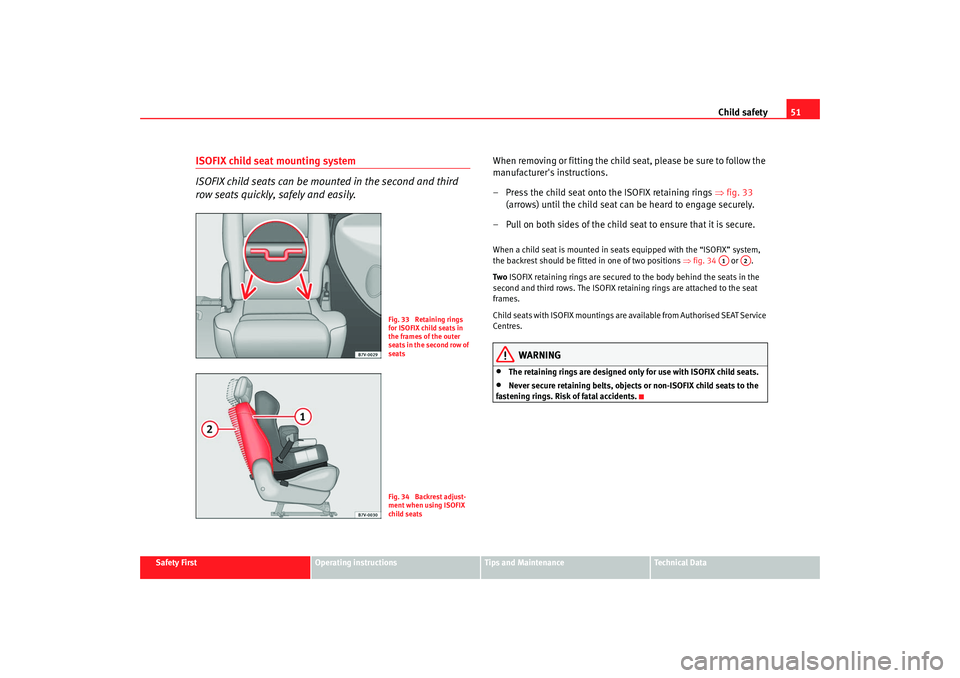
Child safety51
Safety First
Operating instructions
Tips and Maintenance
Te c h n i c a l D a t a
ISOFIX child seat mounting system
ISOFIX child seats can be mounted in the second and third
row seats quickly, safely and easily.
When removing or fitting the child seat, please be sure to follow the
manufacturer's instructions.
– Press the child seat onto the ISOFIX retaining rings ⇒fig. 33
(arrows) until the child seat can be heard to engage securely.
– Pull on both sides of the child seat to ensure that it is secure.When a child seat is mounted in seats equipped with the “ISOFIX” system,
the backrest should be fitted in one of two positions ⇒fig. 34 or .
Two ISOFIX retaining rings are secured to the body behind the seats in the
second and third rows. The ISOFIX retaining rings are attached to the seat
frames.
Child seats with ISOFIX mountings are available from Authorised SEAT Service
Centres.
WARNING
•
The retaining rings are designed only for use with ISOFIX child seats.
•
Never secure retaining belts, objects or non-ISOFIX child seats to the
fastening rings. Risk of fatal accidents.
Fig. 33 Retaining rings
for ISOFIX child seats in
the frames of the outer
seats in the second row of
seatsFig. 34 Backrest adjust-
ment when using ISOFIX
child seats
A1
A2
alhambra ingles.book Seite 51 Donnerstag, 19. April 2007 4:04 16
Page 54 of 291
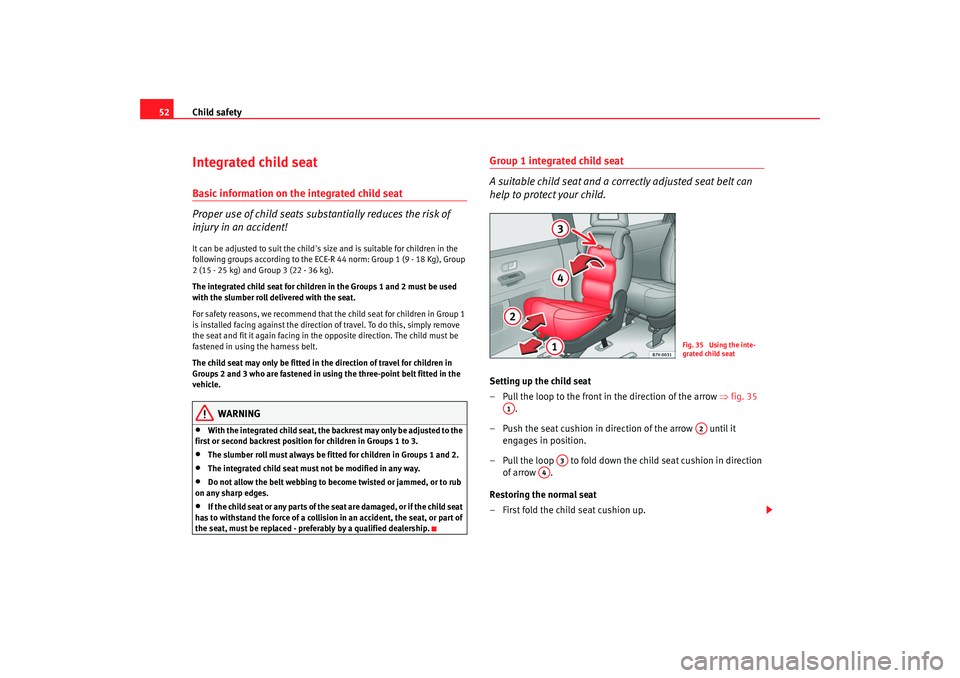
Child safety
52Integrated child seatBasic information on the integrated child seat
Proper use of child seats substantially reduces the risk of
injury in an accident!It can be adjusted to suit the child's size and is suitable for children in the
following groups according to the ECE-R 44 norm: Group 1 (9 - 18 Kg), Group
2 (15 - 25 kg) and Group 3 (22 - 36 kg).
The integrated child seat for children in the Groups 1 and 2 must be used
with the slumber roll delivered with the seat.
For safety reasons, we recommend that th e child seat for children in Group 1
is installed facing against the direction of travel. To do this, simply remove
the seat and fit it again facing in the opposite direction. The child must be
fastened in using the harness belt.
The child seat may only be fitted in the direction of travel for children in
Groups 2 and 3 who are fastened in usin g the three-point belt fitted in the
vehicle.
WARNING
•
With the integrated child seat, the backrest may only be adjusted to the
first or second backrest position for children in Groups 1 to 3.
•
The slumber roll must always be fitted for children in Groups 1 and 2.
•
The integrated child seat must not be modified in any way.
•
Do not allow the belt webbing to become twisted or jammed, or to rub
on any sharp edges.
•
If the child seat or any parts of the seat are damaged, or if the child seat
has to withstand the force of a collisio n in an accident, the seat, or part of
the seat, must be replaced - preferably by a qualified dealership.
Group 1 integrated child seat
A suitable child seat and a corr ectly adjusted seat belt can
help to protect your child.Setting up the child seat
– Pull the loop to the front in the direction of the arrow ⇒fig. 35
.
– Push the seat cushion in direction of the arrow until it engages in position.
– Pull the loop to fold down the child seat cushion in direction of arrow .
Restoring the normal seat
– First fold the child seat cushion up.
Fig. 35 Using the inte-
grated child seat
A1
A2
A3
A4
alhambra ingles.book Seite 52 Donnerstag, 19. April 2007 4:04 16
Page 55 of 291
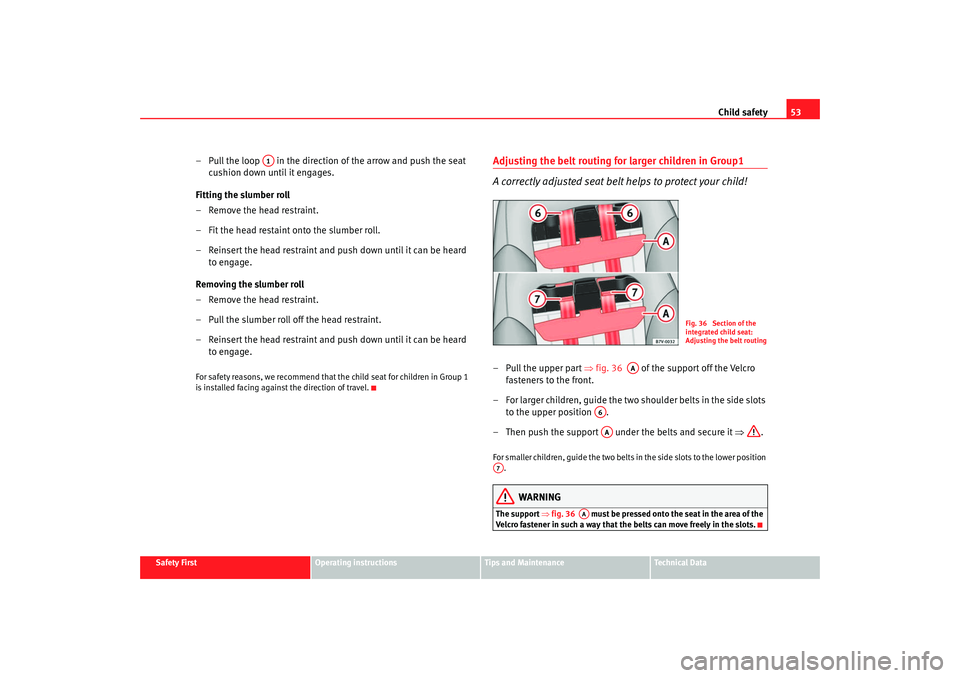
Child safety53
Safety First
Operating instructions
Tips and Maintenance
Te c h n i c a l D a t a
– Pull the loop in the direction of the arrow and push the seat
cushion down until it engages.
Fitting the slumber roll
– Remove the head restraint.
– Fit the head restaint onto the slumber roll.
– Reinsert the head restraint and push down until it can be heard to engage.
Removing the slumber roll
– Remove the head restraint.
– Pull the slumber roll off the head restraint.
– Reinsert the head restraint and push down until it can be heard to engage.For safety reasons, we recommend that the child seat for children in Group 1
is installed facing against the direction of travel.
Adjusting the belt routing for larger children in Group1
A correctly adjusted seat belt helps to protect your child!–Pull the upper part ⇒ fig. 36 of the support off the Velcro
fasteners to the front.
– For larger children, guide the two shoulder belts in the side slots to the upper position .
–Then push the support unde r the belts and secure it ⇒.For smaller children, guide the two belts in the side slots to the lower position
.
WARNING
The support ⇒fig. 36 must be pressed onto the seat in the area of the
Velcro fastener in such a way that the belts can move freely in the slots.
A1
Fig. 36 Section of the
integrated child seat:
Adjusting the belt routing
AA
A6AA
A7
AA
alhambra ingles.book Seite 53 Donnerstag, 19. April 2007 4:04 16
Page 56 of 291
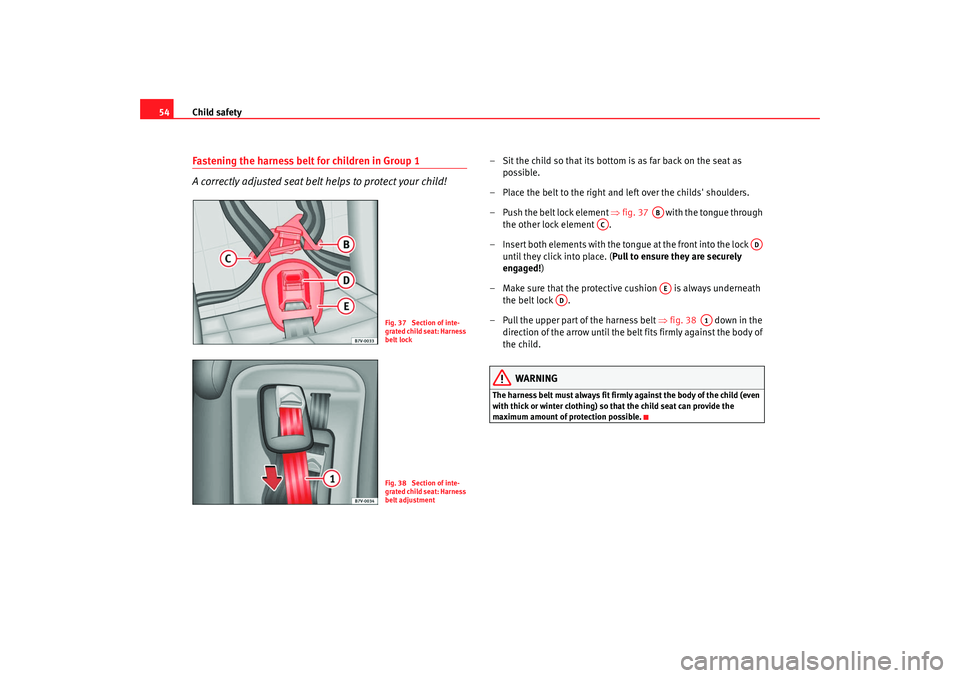
Child safety
54Fastening the harness belt for children in Group 1
A correctly adjusted seat belt helps to protect your child!
– Sit the child so that its bottom is as far back on the seat as
possible.
– Place the belt to the right and left over the childs' shoulders.
– Push the belt lock element ⇒fig. 37 with the tongue through
the other lock element .
– Insert both elements with the tongue at the front into the lock until they click into place. ( Pull to ensure they are securely
engaged! )
– Make sure that the protective cushion is always underneath the belt lock .
– Pull the upper part of the harness belt ⇒ fig. 38 down in the
direction of the arrow until the belt fits firmly against the body of
the child.
WARNING
The harness belt must always fit firmly against the body of the child (even
with thick or winter clothing) so that the child seat can provide the
maximum amount of protection possible.
Fig. 37 Section of inte-
grated child seat: Harness
belt lockFig. 38 Section of inte-
grated child seat: Harness
belt adjustment
AB
AC
AD
AE
AD
A1
alhambra ingles.book Seite 54 Donnerstag, 19. April 2007 4:04 16
Page 57 of 291
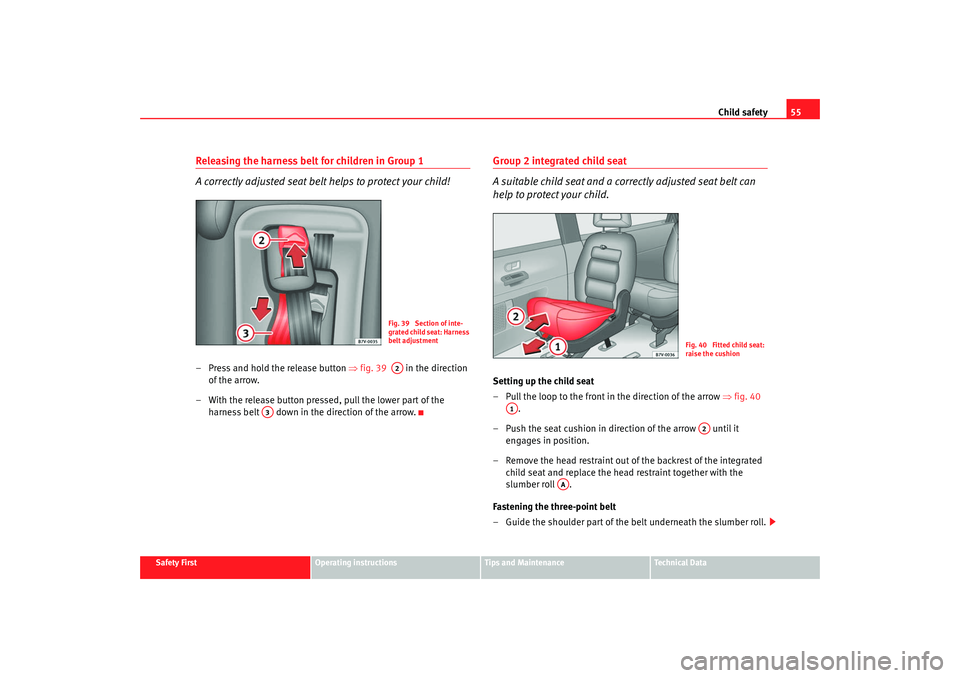
Child safety55
Safety First
Operating instructions
Tips and Maintenance
Te c h n i c a l D a t a
Releasing the harness belt for children in Group 1
A correctly adjusted seat belt helps to protect your child!– Press and hold the release button ⇒ fig. 39 in the direction
of the arrow.
– With the release button pressed, pull the lower part of the harness belt down in the direction of the arrow.
Group 2 integrated child seat
A suitable child seat and a corr ectly adjusted seat belt can
help to protect your child.Setting up the child seat
– Pull the loop to the front in the direction of the arrow ⇒fig. 40
.
– Push the seat cushion in direction of the arrow until it engages in position.
– Remove the head restraint out of the backrest of the integrated child seat and replace the head restraint together with the
slumber roll .
Fastening the three-point belt
– Guide the shoulder part of the belt underneath the slumber roll.
Fig. 39 Section of inte-
grated child seat: Harness
belt adjustmentA2
A3
Fig. 40 Fitted child seat:
raise the cushion
A1
A2
AA
alhambra ingles.book Seite 55 Donnerstag, 19. April 2007 4:04 16
Page 58 of 291
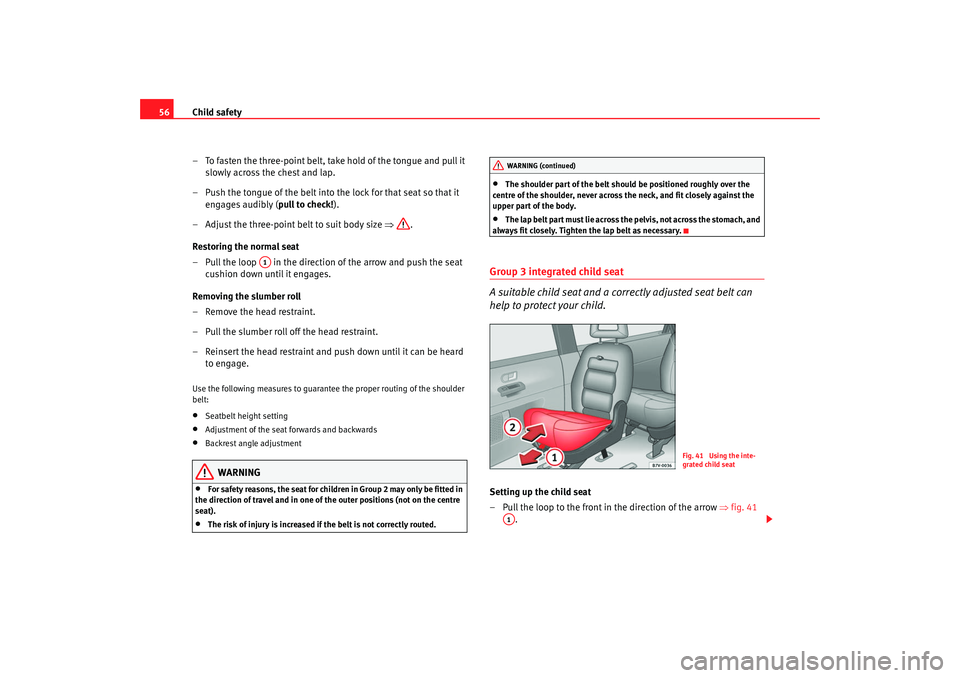
Child safety
56
– To fasten the three-point belt, take hold of the tongue and pull it slowly across the chest and lap.
– Push the tongue of the belt into the lock for that seat so that it engages audibly ( pull to check!).
– Adjust the three-point be lt to suit body size ⇒.
Restoring the normal seat
– Pull the loop in the direction of the arrow and push the seat
cushion down until it engages.
Removing the slumber roll
– Remove the head restraint.
– Pull the slumber roll off the head restraint.
– Reinsert the head restraint and push down until it can be heard to engage.Use the following measures to guarantee the proper routing of the shoulder
belt:•
Seatbelt height setting
•
Adjustment of the seat forwards and backwards
•
Backrest angle adjustment
WARNING
•
For safety reasons, the seat for children in Group 2 may only be fitted in
the direction of travel and in one of the outer positions (not on the centre
seat).
•
The risk of injury is increased if the belt is not correctly routed.
•
The shoulder part of the belt should be positioned roughly over the
centre of the shoulder, never across the neck, and fit closely against the
upper part of the body.
•
The lap belt part must lie across the pelvis, not across the stomach, and
always fit closely. Tighten the lap belt as necessary.
Group 3 integrated child seat
A suitable child seat and a corr ectly adjusted seat belt can
help to protect your child.Setting up the child seat
– Pull the loop to the front in the direction of the arrow ⇒fig. 41
.
A1
WARNING (continued)
Fig. 41 Using the inte-
grated child seat
A1
alhambra ingles.book Seite 56 Donnerstag, 19. April 2007 4:04 16
Page 59 of 291
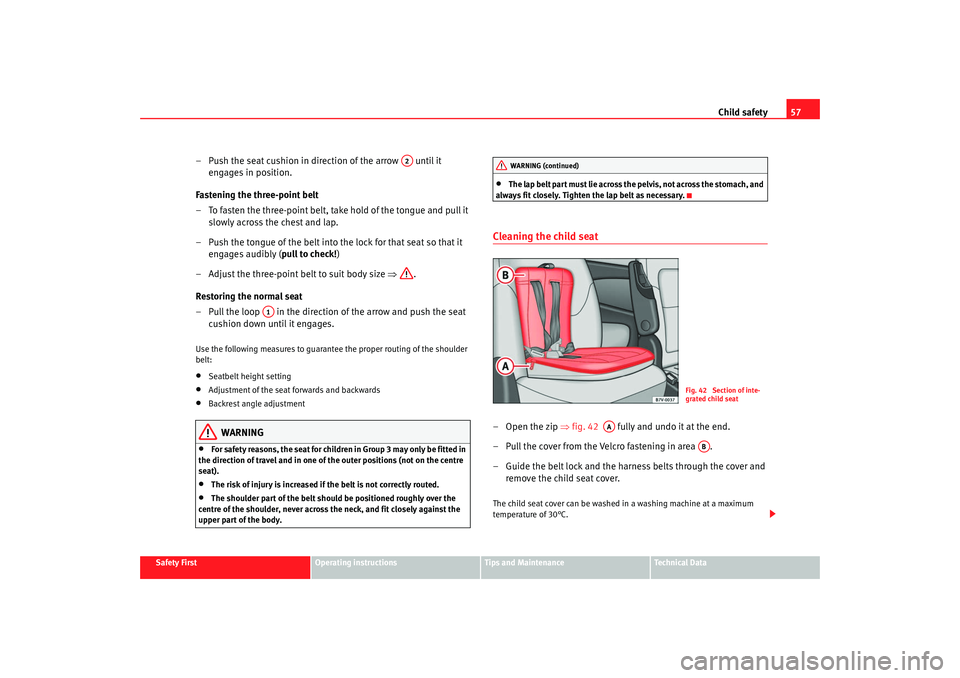
Child safety57
Safety First
Operating instructions
Tips and Maintenance
Te c h n i c a l D a t a
– Push the seat cushion in direction of the arrow until it
engages in position.
Fastening the three-point belt
– To fasten the three-point belt, take hold of the tongue and pull it slowly across the chest and lap.
– Push the tongue of the belt into the lock for that seat so that it engages audibly ( pull to check!)
– Adjust the three-point belt to suit body size ⇒.
Restoring the normal seat
– Pull the loop in the direction of the arrow and push the seat
cushion down until it engages.Use the following measures to guarantee the proper routing of the shoulder
belt:•
Seatbelt height setting
•
Adjustment of the seat forwards and backwards
•
Backrest angle adjustment
WARNING
•
For safety reasons, the seat for children in Group 3 may only be fitted in
the direction of travel and in one of the outer positions (not on the centre
seat).
•
The risk of injury is increased if the belt is not correctly routed.
•
The shoulder part of the belt shou ld be positioned roughly over the
centre of the shoulder, never across the neck, and fit closely against the
upper part of the body.
•
The lap belt part must lie across th e pelvis, not across the stomach, and
always fit closely. Tighten the lap belt as necessary.
Cleaning the child seat– Open the zip ⇒fig. 42 fully and undo it at the end.
– Pull the cover from the Velcro fastening in area .
– Guide the belt lock and the harness belts through the cover and remove the child seat cover.The child seat cover can be washed in a washing machine at a maximum
temperature of 30°C.
A2
A1
WARNING (continued)
Fig. 42 Section of inte-
grated child seat
AA
AB
alhambra ingles.book Seite 57 Donnerstag, 19. April 2007 4:04 16
Page 60 of 291
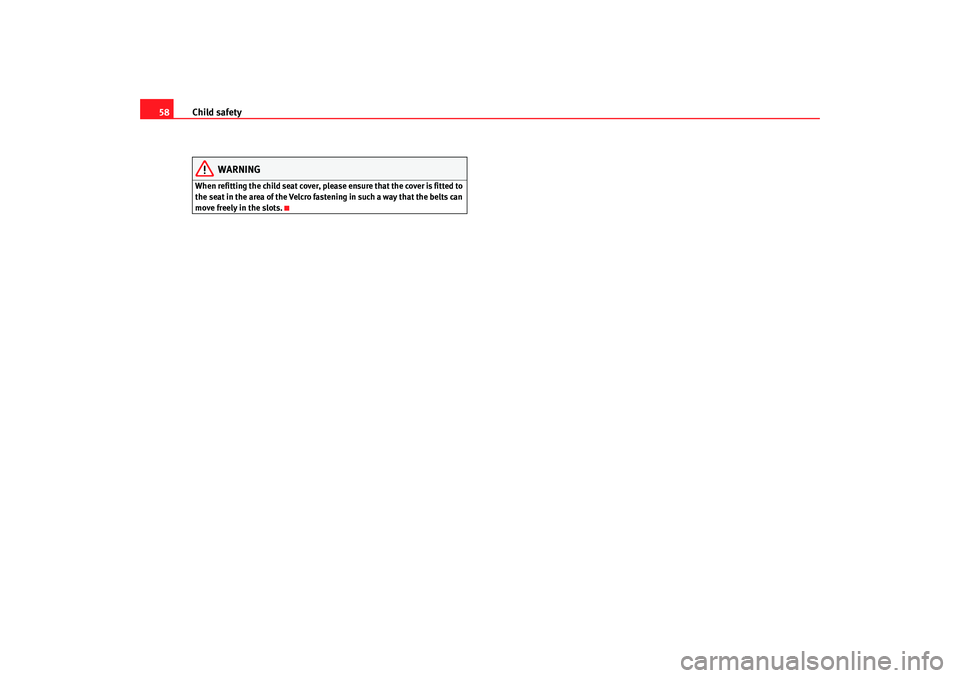
Child safety
58
WARNING
When refitting the child seat cover, pl ease ensure that the cover is fitted to
the seat in the area of the Velcro fa stening in such a way that the belts can
move freely in the slots.
alhambra ingles.book Seite 58 Donnerstag, 19. April 2007 4:04 16